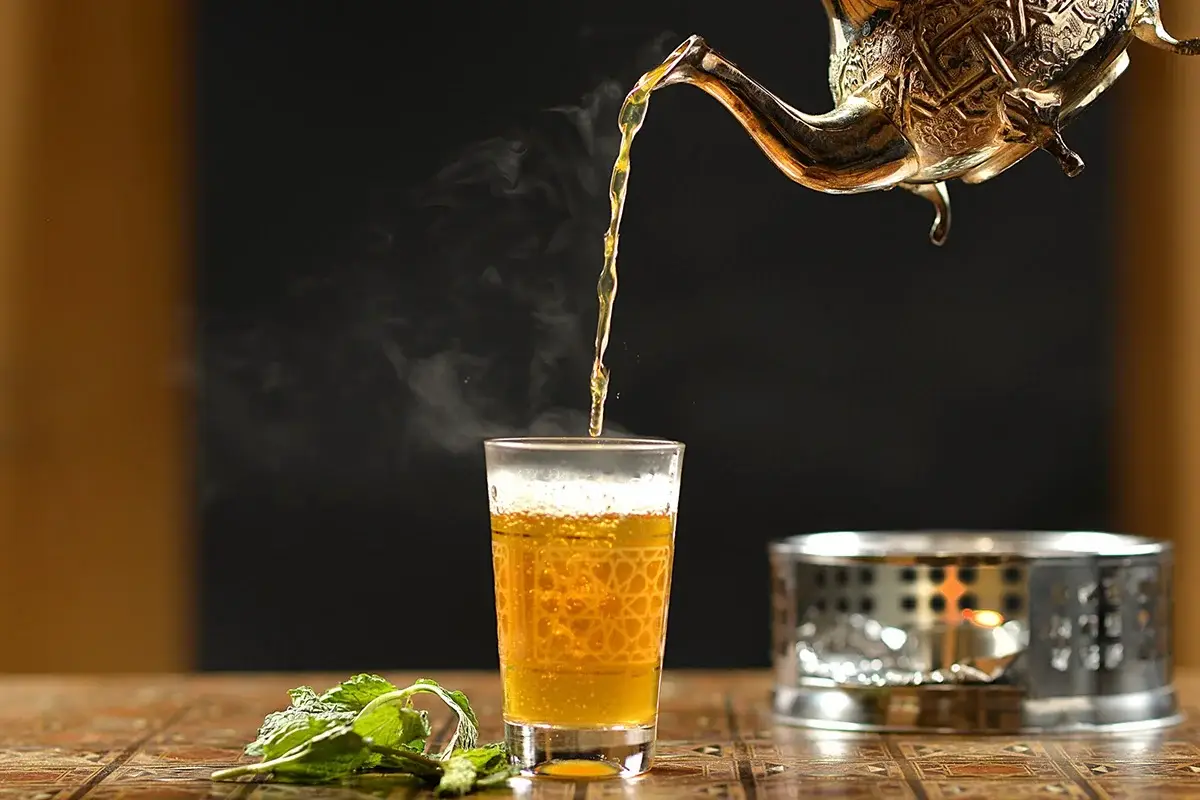Recipe: How to Make Moroccan Tea like Locals

Moroccan tea, known as “Atay,” is a national symbol of hospitality and culture. Making tea the Moroccan way is both an art and a tradition, deeply rooted in daily life. Here’s a guide to making authentic Moroccan tea with step-by-step instructions.
Ingredients & Equipment Needed
- Waterpot – for boiling water
- Teapot – a classic Moroccan teapot is preferred
- Green Tea – typically Chinese gunpowder tea
- Fresh Mint – ideally large sprigs of mint
- Sugar – adjust to taste, though Moroccans traditionally use a generous amount
Step-by-Step Instructions
- Boil the Water: Start by filling your waterpot and bringing the water to a boil. While it heats, prepare your teapot.
- Prepare the Green Tea: Add green tea leaves to your teapot, adjusting the amount based on its size. For a large teapot (1 liter and more), use about a handful of tea leaves. If your teapot is smaller, reduce the portion accordingly.). Pour a bit of hot water over the leaves to rinse them, swirling gently to remove dust and bitterness. Discard this water, leaving only the moist leaves.
- Add Fresh Mint: Take a bunch of fresh mint and gently twist it to release the the flavour. Place it into the teapot over the tea leaves.
- Add the Boiled Water: Once the water reaches a boil, pour it into the teapot until it’s nearly full.
- Sweeten to Taste: Add sugar, adjusting based on preference. Traditionally, Moroccans enjoy their tea quite sweet, though this varies by region and household. Allow the tea to steep for about two minutes.
- Mix the Tea: To blend the flavors, pour a cup of tea into an empty glass, then pour it back into the teapot.
- Serving: Moroccan tea is often poured from a height, a tradition that shows hospitality and enhances the aroma. This also creates a frothy foam on top, which is considered a sign of well-made tea. A good tea should have a clear golden-green color, neither too yellow nor too brown. Brown tea, strong and bitter, is generally preferred after heavy meals (Also served in the southern parts of Morocco), while lighter tea is enjoyed at breakfast or in the evening.

Personal Notes on Sweetness and Serving
While most Moroccans drink tea with sugar, the amount can vary across regions. Personally, I enjoy mine without sugar on a daily basis to savor the mint and tea flavors, especially when paired with Morocco’s sweet pastries. When hosting, many families now make two teapots: one sweetened, the other unsweetened, catering to varying preferences.
It’s about Trial and Error
Don’t worry if it doesn’t turn out perfect at first; Moroccan tea-making is a skill to develop. Tea strength can vary depending on the brand or type, and you might find that some teas need a lot to be flavorful, while others only need a small scoop.
If your tea is too strong and turns brown, add more boiled water to dilute it. If it’s yellowish and too weak, add a little more tea. For flavor, fresh mint can make a big difference; add extra if the taste needs a boost. Keep experimenting to find the perfect balance!
Atay Chamali: A Northern Moroccan Tea Tradition

Atay Chamali, specific to northern cities like Chefchaouen, Tetouan, and Tangier, is served differently. Instead of using a teapot, tea is poured directly into tall glasses with fresh mint and sugar already added. This style results in a lighter tea with a bold mint flavor, offering a refreshing variation on traditional Moroccan tea.
Get the ingredients and make your self the Best Cup of Tea !
Moroccan tea, whether served in a teapot or a tall glass, is more than just a drink—it’s a reflection of Morocco’s warmth, generosity, and love for gathering. With its soothing sweetness and lightness, it’s a balm to the soul. So, gather your ingredients and enjoy a taste of Morocco! And if you’d like more recipes or need help planning your Moroccan adventure, feel free to reach out. Enjoy!












Comment (1)
Why Moroccan Cuisine is the Best Cuisine in the World
says November 12, 2024 at 1:50 pm[…] readers interested in a traditional Moroccan tea experience, be sure to check out my guide on how to make Moroccan tea like a local. This guide offers insights into preparing and serving […]